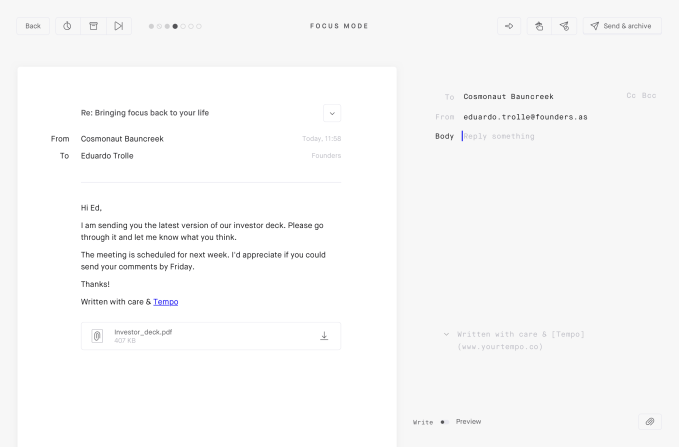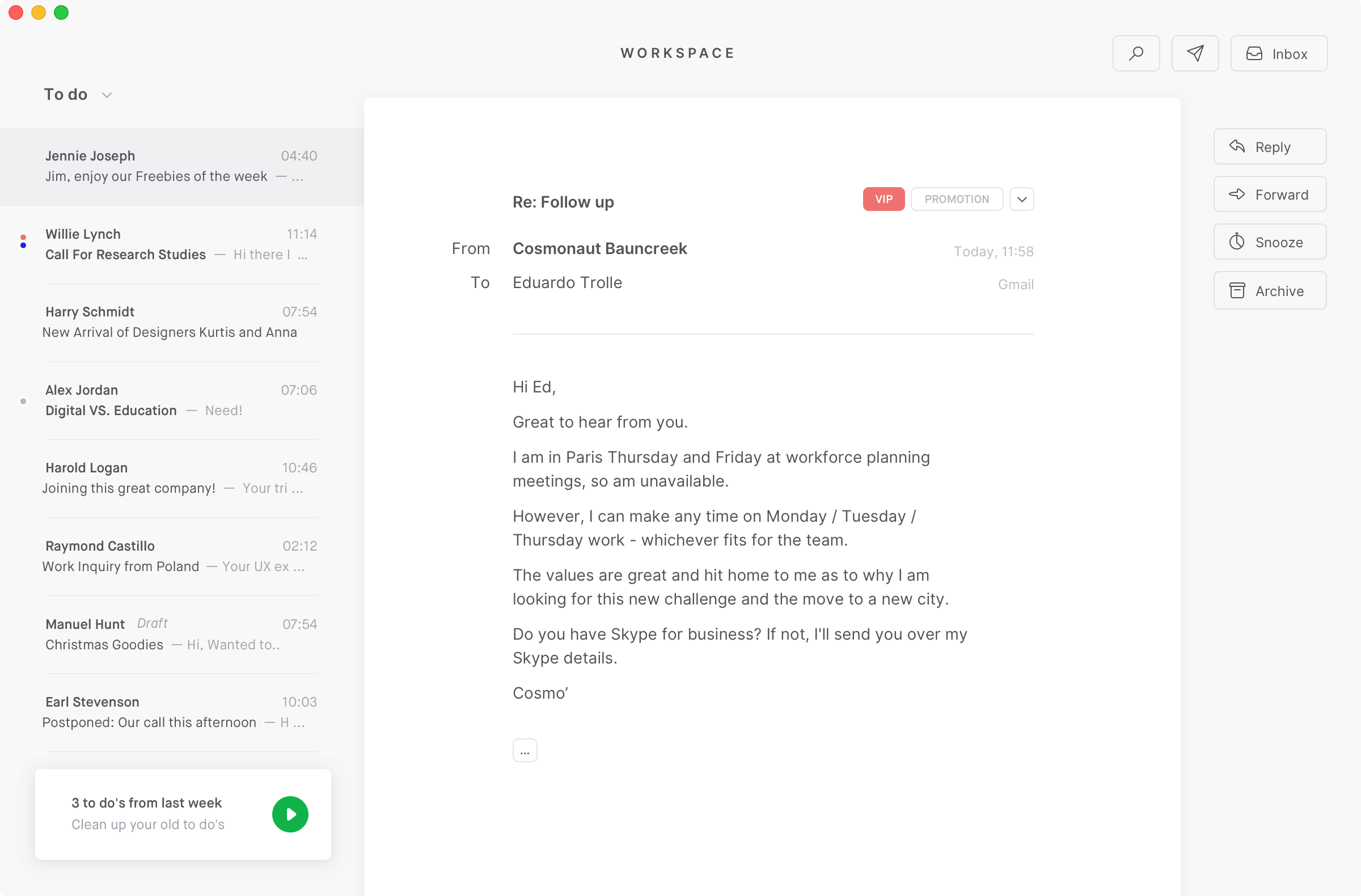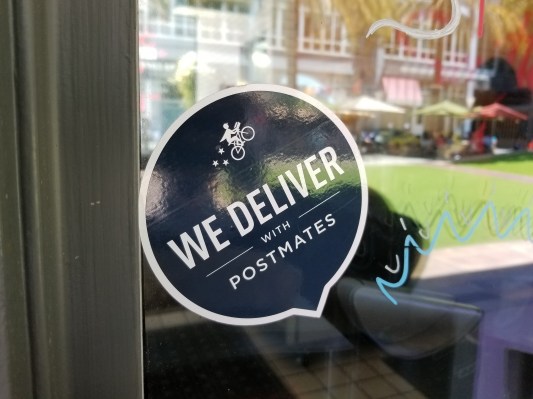Music
Trailers
DailyVideos
India
Pakistan
Afghanistan
Bangladesh
Srilanka
Nepal
Thailand
StockMarket
Business
Technology
Startup
Trending Videos
Coupons
Football
Search
Download App in Playstore
Download App
Best Collections
Technology
Email will likely never die, but if new apps can change how we think about using it, maybe it will feel like the worst parts have croaked.
In the wake of popular apps like Inbox and Mailbox being sunsetted, like many, I&ve been left rudderless trying to find an email client that fills the void. I&ve been experimenting with so-called premium email clients for a while, and a tiny team in Copenhagen has built what has become my favorite as of late.

Tempo is an email app — currently in free beta — that tries to minimize distractions while helping you be more deliberate and less obsessive about email.
&We believe that we can provide something better for email, but you can&t be everything for everybody,& co-founder Sebastian Stockmarr told TechCrunch in an interview. &I think we&re ready for this fragmentation of the market where we can actually have these niche products, but then they&re still for the most widely used technology for communication.&
ItMac-only for Gmail users at the moment, though Android, iOS and Windows platform-support are all on the docket.
Tempo niche has grown a bit since development began, and the co-founders have eased up on some of their originally spartan design choices that included a desktop app where you couldn&t access your full inbox and a beta mobile app that didn&t allow you to reply to emails at all.
The radical design decisions were originally made to organize around the idea that being a slave to notifications was bad for productivity and that email was never meant to be an ever-present life blood. The app had &hard-coded in good habits,& Stockmarr told me. Over time, the app has become more appealing to a general user, but as the company prepares to launch their mobile app, they are trying to ensure that they can stop their users from defaulting to bad habits with the proper interface.
&Mobile is a pretty important piece,& Stockmarr says. &If we want to allow people to focus more and be less disturbed by things, I think the biggest killer of that is in our pockets.&
The app has just emerged from its invite-only days in recent weeks and after relying on it for the past couple of months, I&ve really begun to enjoy some of its intricacies. The most recent email service I spent time with was Superhuman, so expect a few comparisons.
Tempo is an email app thatabout directing your focus. Workplace toolsets are so often about sending you mixed signals that drag you out of deep work. Tempo is a design-focused desktop email app that encourages you to give your all to it while itfullscreen on your computer, and then to let your more trivial emails fade while you get to your other work.
The fundamental difference between the two apps is that Superhuman has optimized for users to get in and out of the app quickly so they can stay current, but Tempo is more focused on you settling into the app but using it less per day. True to the sell, I&ve ended up checking my email less with Tempo, but I spend more time in the app sending more emails when I do.
The most useful feature of Superhuman was splitting the inbox into messages that were sent only to you and ones that are more likely to be spam or low-priority. You aren&t currently able to designate new inbox buckets or set your own rules, which is something that may hold back power users from adopting it.
&Focus& is a dedicated mode inside the app that just tosses your most recent email in fullscreen glory right in front of you, and gives you the option to archive it, delete it, send it to the workspace or pound out a quick reply. The quick replies are kind of fun; they somewhat arbitrarily give you a 140-character &limit& that you of course can blow through, but Tempo finds places to encourage you to just get done what you need to rather than rattling on.

Tempoworkspace (image via Tempo)
The workspace is probably the main distinguishing feature of the app — ita to-do list that you stock with emails that probably warranted more than a quick reply and may necessitate a few messages before they&re safely out of mind. Combining a getting-things-done interface with your inbox makes a lot of sense, given how parallel the mantras of GTD and inbox-zero are. One feature that I don&t use, because I can&t really afford to as a reporter (or so I tell myself), is scheduled notifications, where you are only sent a desktop notification or two per day letting you know that you have emails to check. You can schedule when these arrive and it encourages you to not be afraid to let a few emails build up in your inbox rather than obsessively checking them.
There are still some design quirks I don&t love, especially regarding how search works, some of the reply/forward mechanics and the occasional beta bugginess, but it seems to help me be healthier about email without feeling too preachy. While competing apps like Superhuman are putting the emphasis on speed, Tempofounders say that shaving milliseconds from open times isn&t where much of their focus lies.
&Speed, in itself, is not a goal for us,& Stockmarr tells TechCrunch.
That seems pretty in-line with the productdesign ethos, but it also might have something to do with the fact that Tempo just has five people on its team and isn&t looking to raise any big venture rounds soon, saying that they believe they&re within sight of profitability with the current funding from the design studio Founders inside which Tempo sits.
TempoMac desktop app is currently free, but once the startup launches their mobile app, they&re planning to charge $15 per month for the service. The service might cost half of Superhuman$30/mo, but the test for the startup will be forcing users to compare how the app makes them feel about their relationship with email versus how it makes their credit card feel.
- Details
- Category: Technology
Read more: Subscription email app Tempo hits the right minimalist notes
Write comment (99 Comments)
An employee of Facebook died by apparent suicide Thursday morning, Menlo Park police reported and the company confirmed.
&We were saddened to learn that one of our employees passed away at our Menlo Park headquarters earlier today,& a Facebook spokesperson told TechCrunch in an email.
The male employee was pronounced dead at the scene, which was near the 100 block of Jefferson Drive at a building on FacebookMenlo Park campus. Police say that after preliminary investigations they do not suspect any foul play.
&Menlo Park Police Officers and Menlo Park Fire Protection District personnel responded, and when they arrived, found the victim unresponsive,& a police press release reads.
&We&re cooperating with police in their investigation and providing support to employees. While the family is being notified, we have no information to share. We hope to provide an update when we learn additional information from law enforcement,& the Facebook spokesperson further noted.
If you or someone you know is struggling with depression or has had thoughts of harming themselves or taking their own life, get help.The National Suicide Prevention Lifeline(1-800-273-8255) provides 24/7, free, confidential support for people in distress, as well as best practices for professionals and resources to aid in prevention and crisis situations.
- Details
- Category: Technology
Read more: Facebook employee dies after apparent suicide at company’s Menlo Park headquarters
Write comment (94 Comments)
We&ve known this day would come for a long time now. Over the past several months, however, it feels like it has arrived in slow motion. Seemingly legitimate concerns over security and sanction violations have been muddled by chest-puffing and braggadocio and large-headed leaders promising to do deals. Executives were arrested in Canada and the company was added to a trade blacklist, only to be given a temporary reprieve.
This morning, in spite of it all, Huawei unveiled its latest flagship. The Mate 30 Pro is a beast of a smartphone, as we&ve come to expect from the Chinese electronics powerhouse. It has a quartet of cameras aligned in a ring up top. On the flip side, a 6.53-inch flexible OLED hugs the corners of the handset, boasting an always-on functionality — the long-awaited new feature that served as the central selling point for Applelatest wearable.
From a 100-foot view, however, it seems inevitable that no one will remember the handset for its screen or cameras or beefy 4,500mAh. Itwhatmissing thatthe most notable. The Mate 30 and Mate 30 Pro don&t use full Android, but rather an open-source version of the operating system based on it. More importantly, they are missing Googlefundamental apps like Gmail, Maps and Chrome, a central part of the Android experience. Worse yet, thereno Google Play Store to download them.
The solutions for now are mostly stop-gap. Therea Huawei-branded browser that lets you download apps through a Huawei-branded channel. There are 45,000 or so. Not bad, but nowhere near the 2.7 million you&ll find via Google Play. There will be better solutions to these, but they take a lot of time and money. Huaweigot plenty of the latter, though the former has been the cause for some debate amongst those following the company.
- Details
- Category: Technology
Read more: The Mate 30 is a moment of truth for Huawei
Write comment (96 Comments)The super apps WeChat and Alipay became an integral part of the Chinese mobile ecosystem, growing to more than 1 billion monthly active users (MAU) and 1 billion annual active users (AAU), respectively. They both offer services from food delivery and bike sharing to a full suite of financial services such as payment, insurance and investments.
Now, companies from around the world are trying to replicate the successful Chinese model in their region. And Latin America is an especially compelling region for the emergence of super apps, due to its vast population, almost 650 million, distributed in more or less similar countries regarding language, culture and religion. It also has a mobile-first population with 62% of smartphone penetration, according toGSMA data.
The expansion of the super apps model
After the incredible success of WeChat and Alipay, many companies around the world decided to replicate their model in different regions. Due to the proximity to China and its influence and money, Southeast Asia was one of the first regions in which super apps started to appear. The Singaporean ride-hailing Grab and the Indonesian Go-Jek both raised billions of dollars to not only successfully block the expansion of Uber in the region but also to expand their portfolio of services provided beyond ride-hailing to food delivery, payments and other services.
Note that not all super apps are the same.
In India, payTM is expanding beyond its core service and positioning itself to be the leading player in the country, especially after Tapzo was acquired by Amazon last year and closed.
It is interesting to note that not all super apps are the same. Alipay came from the e-commerce Alibaba and is more focused on financial services, while WeChat started as a messenger app, expanding not only to financial services but also to daily services such as e-commerce, gaming, travel and many others. In Southeast Asia, Go-Jek and Grab started as ride-hailing, expanding to delivery before going to financial services, and payTM started as a prepaid recharge mobile platform and then moved to offer a range of financial and daily services.
So, what to expect in Latin America?
Latin American super apps should develop themselves in their own particular way, as the environment in the region is quite different from the one in China.
The internet ecosystem in the region is highly influenced by European and American tech companies that dominate segments such as communication, music, search and many others. It is quite hard for a local startup to compete in those markets. However, there are a few battlegrounds that are not as easy to dominate from abroad, such as ride-hailing, food delivery and finance. Those are on-the-ground or highly regulated industries that are very hard to scale, especially across different countries. Those are precisely the industries in which we have seen the emergence of some super apps candidates, fueled by an unprecedented amount of venture capital investment in the region.
The most prominent candidate to super app in the region is the Colombian on-demand delivery Rappi. It is one of the most funded startups in Latin America, backed by titans such as Sequoia, Andreessen Horowitz and SoftBank, which have poured US$ 1.4 billion in investments so far. Although it started offering just food delivery, it now provides services such as e-scooter, payments, P2P transfer, movie theater tickets and a debit card. It also operates in the most relevant countries in the region: Brazil, Mexico, Colombia, Argentina, Chile, Uruguay and Peru.
Another strong candidate is the financial side of the e-commerce behemoth Mercado Libre (MELI),Mercado Pago. It started as a way to enable payment between users in the marketplace; however, it grew to offer a diverse portfolio of financial services such as online and offline payment, bill payments and, more recently, investment (through itsMercado Fondo). Thanks to its parent company, itpretty much all over Latin America, and processes around 400 million transactions annually.
The Brazilian Movile is also positioning itself as a strong competitor. The company already has a diverse portfolio of services, from delivery food to event tickets, courier and even a kids Netflix, operating in Brazil, Mexico, Colombia and Argentina. Not only did it raise a total of US$395 million investment, but also one of its companies, iFood, raised a total of US$592 million.
Latin America is an especially compelling region for the emergence of super apps.
The Spanish Cabify is another company trying to position itself as a super app. It recently started to offer e-scooters and bike service, as well as financial services through its own fintech company, Lana. Even though it raised US$477 million in funding, it will be hard for Cabify to become a super app, as the ride-hailing competition is getting quite intense in the region. Its competitors Uber and Didi are also adding more services and trying to position themselves.
An interesting potential competitor would be Nubank, the Brazilian decacorn (private companies with more than US$10 billion of valuation). It already has more than 8 million customers in Brazil and is starting to expand in the region to Mexico, Argentina and Colombia. Although Nubank still only offers traditional financial services, it has Tencent as a significant investor and has raised US$1.1 billion, so far. Therefore, it would be no surprise if it decides to follow a similar path as WeChat.
Also, in Brazil, Banco Inter (BIDI11) recentlylaunched a marketplace to expand the offer to its customers beyond financial services to e-commerce, travel and more. The challenger bank is already a public company with around US$7 billion valuation, but it is now backed by SoftBank after its latest share offer.
Those are the most well-positioned candidates to be super apps in Latin America. Even so, other players could surprise, such as Magazine Luiza, leading retail and e-commerce in Brazil. Its CEO is transforming the company from a brick-and-mortar retail to a technology company and already showed its ambition to transform MagaLu (its app) into a super app offering many other services. Although it could compete in the Brazilian market, it would be doubtful that it becomes a regional player, as its primary business operates only in Brazil.
Super apps in Latin America will not be the same as in China
We are starting to see the rise of the super apps in Latin America, but they will not follow the Chinese path as the markets are very different. A better comparison could be with the Southeast Asian players as the markets are more similar; however, Latin Americansuper apps will probably be the result of the unique environment in the region.
As more companies are looking into the Chinese success stories, we will probably see even more players competing to become the Latin American super app. The venture capitalists are already placing their bets on who will become the leading players in Latin America. One thing is certain: It will be exhilarating to see how the market unfolds in the region — the customers will be the true winners in this battle.
- Details
- Category: Technology
Read more: The emergence of super apps in Latin America
Write comment (93 Comments)Twitter controversial &Hide Replies& feature, aimed at civilizing conversations on its platform, is launching today in the U.S. and Japan after earlier tests in Canada. The addition is one of the more radical changes to Twitter to date. It puts people back in control of a conversation they&ve started by giving them the ability to hide those contributions they think are unworthy.
These replies, which may range from the irrelevant to the outright offensive, aren&t actually deleted from Twitter. They&re just put behind an extra click.
That means people who come into a conversation to cause drama, make inappropriate remarks or bully and abuse others won&t have their voices heard by the majority of the conversationparticipants. Only those who choose to view the hidden replies will see those posts.

Other social media platforms don&t give so much power to commenters to disrupt conversations. On Facebook and Instagram, for example, you can delete any replies to your own posts.
But Twitter has a different vibe. Itmeant to be a public town square, where everyone has a right to speak (within reason.)
Unfortunately, Twitteropen nature also led to bullying and abuse. Before today, the only options Twitter offered were to mute, block and report users. Blocking and muting, however, only impact your own Twitter experience. You may no longer see posts from those users, but others still could. Reporting a tweet is also a complicated process that takes time. Itnot an immediate solution for a conversation rapidly spinning out of control.
While &Hide Replies& will help address these problems, it ships with challenges of its own, too. It could be used as a way to silence dissenting opinions, including those expressed thoughtfully, or even fact-checked clarifications.
Twitter believes the feature will ultimately encourage people to better behave when posting to its platform.
&We already see people trying to keep their conversations healthy by using block, mute, and report, but these tools don&t always address the issue. Block and mute only change the experience of the blocker, and report only works for the content that violates our policies,&explained TwitterPM of Health Michelle Yasmeen Haqearlier this year.

Since launching in Canada in July, Twitter said that people mostly used the feature to hide replies they found were irrelevant, abusive or unintelligible. User feedback was positive, as well, as those who used the tool said they found it was a helpful way to control what they saw, similar to keyword muting.
In a survey, 27% of those who had their tweets hidden said they would reconsider how they interact with others in the future, Twitter said. Thatnot a large majority, but itenough to make a dent. However, itunclear how representative this survey was. Twitter declined to say how many people used the feature or how many were surveyed about its impacts.
The system will now also ask users who hide replies if they also want to block the account, as a means of clarifying that &hiding& is a different function.
&These are positive and heartening results: the feature helped people have better conversations, and was a useful tool against replies that deterred from the personoriginal intent,& explained Twitter in a blog post, shared today. &We&re interested to see if these trends continue, and if new ones emerge, as we expand our test to Japan and the U.S. People in these markets use Twitter in many unique ways, and we&re excited to see how they might use this new tool,& the post read.
Despite the expansion, Twitter says &Hide Replies& is still considered a test as the company is continuing to evaluate the system, and itnot available to Twitterglobal user base.
The new feature will start rolling out at 2 PM PT in both the U.S. and Japan and will be available across mobile and web clients.
- Details
- Category: Technology
Read more: Twitter launches its controversial ‘Hide Replies’ feature in the US and Japan
Write comment (97 Comments)
Postmates, the popular food delivery service, has raised another $225 million at a valuation of $2.4 billion, the company confirmed to TechCrunch on Thursday, ahead of an imminent initial public offering.
Private equity firm GPI Capital has led the investment, first reported by Forbes, which brings Postmates& total funding to nearly $1 billion. GPI takes non-controlling stakes — between 2% and 20% — in both late-stage private companies and publicly listed ventures.
After tapping JPMorgan Chase and Bank of America to lead its float, Postmates filed privately with the Securities and Exchange Commission for an IPO earlier this year. Sources familiar with the companyexit plans say the business intends to publicly unveil its IPO prospectus this month.
To discuss the companyjourney to the public markets and the challenges ahead in the increasingly crowded food delivery space, Postmates co-founder and chief executive officer Bastian Lehmann will join us onstage at TechCrunch Disrupt on Friday October 4th.
As Forbes noted, last-minute financings are critical for companies poised to run out of cash and in need of an infusion prior to hitting the public markets. The motives for Postmates& last-minute financing are unclear; however, the company will certainly begin trading on the stock market at an interesting time. 2019 has proven to be the year of unicorn listings, and former Silicon Valley darlings like Uber and Lyft have struggled to stabilize since their multi-billion-dollar debuts, despite years of support and coddling from venture capitalists.
Meanwhile, activity in the food delivery space has distracted from Postmates& prospects. DoorDash, for one, recently purchased another food delivery service, Caviar, from Square in a deal worth $410 million. Uber is said to have considered buying Caviar, which had been looking for a buyer at least since 2016,according to Bloomberg. Postmates, for its part, has long been the subject of M-A rumors.
On-demand food delivery, undeniably popular, has yet to prove its long-term viability as a money-making business. At the very least, a sizeable check from a private equity firm ensures Postmates has the capital it needs, for the time being, to accelerate growth and double down on its autonomous robotic delivery ambitions.
Founded in 2011, Postmates is also backed by Spark Capital, Founders Fund, Uncork Capital, Slow Ventures, Tiger Global, Blackrock and others.
- Details
- Category: Technology
Read more: Readying an IPO, Postmates secures $225M led by private equity firm GPI Capital
Write comment (93 Comments)Page 845 of 5614

 19
19





